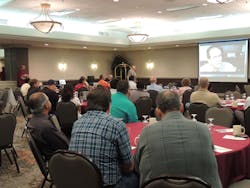Some 100 attendees, including central station companies, alarm dealers and integrators, manufacturers, law enforcement officials and the insurance industry turned out at a seminar on Priority Response hosted by Response Center USA, based in San Antonio, Texas this week and focusing on video alarms and alarm response.
According to J. D. Benfer, president of Response Center USA, the theme of the seminar was the positive message of alarm companies and police using video alarms to make arrests. Response Center USA is a member of Partnership for Priority Video Alarm Response (PPVAR). “PPVAR is changing how the police view the alarm industry (as friendly partners instead of the source of false alarms). The insurance industry has joined the PPVAR and is promoting video alarms to reduce their claims,” Benfer added.
Speaker Michael Gallagher, National Insurance Crime Bureau (NICB) and a special agent for the Southwest Region gave attendees an overview of the NICB and explained that the organization is the link between 1,100 property/casualty insurance companies and law enforcement across the country. The NICB’s 1,100 insurers fund a budget of over $40 million to enable the NICB help law enforcement combat crime. Among some of their efforts, the NICB provides “bait cars” to local police departments to help put car thieves behind bars. They also provide other technology such as cameras and GPS trackers to the police for no charge to help them in their investigations. “Police departments pay attention and the NICB trains over 20,000 officers per year,” Gallagher said. Gallagher explained that NICB joined the PPVAR board of directors because they wanted to help promote priority response as an effective way to reduce property crime, make arrests and reduce losses for their insurers. The NICB confirmed that video alarms deliver arrest rates of over 20 percent and that a single arrest eliminates 30 additional burglaries. The NICB is including PPVAR as part of the training they provide to police departments, helping the alarm industry educate officers who respond to alarms.
The afternoon session was divided among manufacturers CheckVideo, Videofied and Tyco, who each gave presentations on the specific features and capabilities of their individual product lines. The common theme was that a “video alarm” is NOT self-surveillance. Video alarms send the video clip of what caused the alarm to the central station for immediate review and dispatch. Self-surveillance can provide a property owner with remote viewing of their CCTV cameras and even send a clip to the owner—but they do not deliver the video clip to the central station for review and dispatch. This key difference was underscored by each of the presenters. “In contrast to self-surveillance, video alarms are central station-centric and increase the value of monitored alarms that is the core element in the alarm industry business model,” Benfer added.



